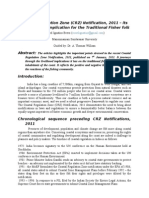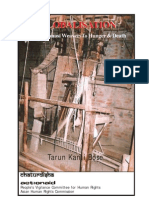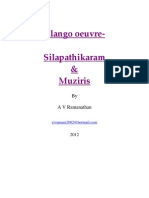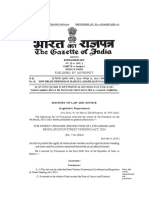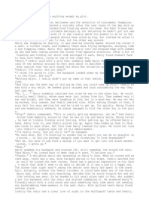Dances in Tamilnadu
Dances in Tamilnadu
Uploaded by
vkumar_345287Copyright:
Available Formats
Dances in Tamilnadu
Dances in Tamilnadu
Uploaded by
vkumar_345287Original Description:
Copyright
Available Formats
Share this document
Did you find this document useful?
Is this content inappropriate?
Copyright:
Available Formats
Dances in Tamilnadu
Dances in Tamilnadu
Uploaded by
vkumar_345287Copyright:
Available Formats
DANCES IN TAMILNADU
Oyil Means Beauty. This Dance Is Hence The Dance Of Beauty. Traditionally, It Is Danced Only By
Men. Ten Years Ago Women Also Began To Participate. This Dance Is Prevalent In The South
Districts And Kongu Nadu In Particular. First A Few People Will Stand In A Row And Start
Dancing With Rhythmic Steps With Musical Accompaniment. Intricate Steps Are Used In Martial
Arts, Such As Silambattam. Then Gradually The Row Will Become Longer As The New Comers
And Guests All Join And Dance Along As They Like. The Dancers Wear Ankle-Bells. Normally, The
Dance Is Performed With The Accomplishment Of Musical Instruments And Songs. It Is
Performed Near The Temples Or Public Places In The Morning And Evening Hours, At Times
Even Till Midnight.
Kummi Is One Of The Most Important And Ancient Forms Of Village Dances Of
Tamilnadu. It Originated When There Were No Musical Instruments, With The
Participants Clapping Their Hands To Keep Time. This Is Performed By Women; Many
Varieties Of Kummi, Such As, Poonthatti Kummi, Deepa Kummi, Kulavai Kummi,
Kadir Kummi, Mulaipari Kummi Etc Are Known. The Women Stand In A Circle And
Dance Clapping Their Hands Rhythamically. This Dance Is Usually Performed During
Temple Festivals, Pongal, The Harvest Festival, Family Functions Like The One To
Celebrate The Coming Of Age (Onset Of Puberty) Of The Girl-Child Etc. The First Line
Of The Song Is Sung By The Leading Lady, Which The Others Repeat.
Kummi
His Dance Is Performed In Temples During Navaratri Festival. The Dancers Wear Ankle-
Bells And Hold Anklets Or Silambu In Their Hands, Which Make Noise When Shaken.
They Perform Various Stepping Styles Jumps. The Dance Is In Praise Of All Female
Deities, The Most Preferred Being The Powerful Angry Goddess - Kali Or Durga
Kai Silambu Attam
The Whirring Sound Of 'Urumi' Providing The Melody And The Beat Of The Thappu Providing The
Rhythm, Accompany The Dance Sequence In This Kind Of Temple Art Form. This Is Performed Especially
In Amman Temples During The Month Of Adi. Nowadays, This Art Form Is Found Only In Selected
Villages In A Few Districts.
Puli Attam Is Performed By Young Men With Painted Bodies In Colours Yellow And Black, Complete With
Fangs, Head Gear With Ears, Paws With Claws And Long Tail, Simulating The Prancing, Ouncing Tiger In
Every Ferocious Move. Wildly Beating Drums Add Frenzy To The Performance.Sometimes, A Goat Is Tied
And Brought Along With The Dancers, Who Pretend To Pounce On It And Kill It. This Dance Is Regularly
Performed During Temple Festivals, Drawing Large Crowds.
Puli Attam Is Performed By Young Men With Painted Bodies In Colours Yellow And Black, Complete With
Fangs, Head Gear With Ears, Paws With Claws And Long Tail, Simulating The Prancing, Ouncing Tiger In
Every Ferocious Move. Wildly Beating Drums Add Frenzy To The Performance.Sometimes, a goat is tied
and
You might also like
- Knock1 Pages DrFtrazDocument213 pagesKnock1 Pages DrFtrazJeff Jeff100% (19)
- KLM e - Ticket - Receipt PDFDocument1 pageKLM e - Ticket - Receipt PDFAngeline LynchNo ratings yet
- Cotton Comforter Seria 6Document32 pagesCotton Comforter Seria 6Heléna Zábó100% (7)
- Study On Kumbh Mela AllahabadDocument81 pagesStudy On Kumbh Mela Allahabadneelfearless75% (8)
- Warhammer Ancient Battles Hannibal and The Punic WarsDocument116 pagesWarhammer Ancient Battles Hannibal and The Punic Warsadlard_matthew100% (5)
- Tamilnadu CultureDocument6 pagesTamilnadu Culturegouthammadipelly360No ratings yet
- Swatchh Bharat AbhiyanDocument13 pagesSwatchh Bharat AbhiyanHRISHI SHARMANo ratings yet
- PTS 5Document32 pagesPTS 5Bharat Mahajan50% (4)
- Arunachal Pradesh 2Document13 pagesArunachal Pradesh 2Alex LeeNo ratings yet
- Intellectual Property Rights - The Indian ScenarioDocument7 pagesIntellectual Property Rights - The Indian ScenariobalajiNo ratings yet
- Chapter 3Document21 pagesChapter 3nitinNo ratings yet
- List of Dams in TamilnaduDocument9 pagesList of Dams in Tamilnaduprisheelabdu100% (1)
- Stdy Hndloom-1 PDFDocument152 pagesStdy Hndloom-1 PDFec_ecNo ratings yet
- Global Financial Crisis Impact On IndiaDocument68 pagesGlobal Financial Crisis Impact On Indiaamititm0% (1)
- A Study of Tourism Industry - Opputunity and ThreatsDocument33 pagesA Study of Tourism Industry - Opputunity and ThreatsbrijeshcocoNo ratings yet
- JnnurmDocument27 pagesJnnurmUttam Kumar50% (2)
- Manual Scavenging Act and Municipal Waste Water Workers in India - Policy and PracticeDocument67 pagesManual Scavenging Act and Municipal Waste Water Workers in India - Policy and PracticeGarvit ChaudharyNo ratings yet
- Coastal Regulation ZoneDocument8 pagesCoastal Regulation ZonerusselignatiusmswNo ratings yet
- Research Paper On PmayDocument6 pagesResearch Paper On PmayReeta SinghNo ratings yet
- 7B - India - Hampi 20150216 ONLINE PublicDocument324 pages7B - India - Hampi 20150216 ONLINE PublicTejaswiniNo ratings yet
- Diagnostic Study Report of Chicken Embroidery, LucknowDocument18 pagesDiagnostic Study Report of Chicken Embroidery, LucknowKavita Nagvanshi100% (1)
- Varanasi As Heritage City (India) On The Scale The UNESCO World Heritage List: From Contestation To Conservation Prof. R P. B. SDocument11 pagesVaranasi As Heritage City (India) On The Scale The UNESCO World Heritage List: From Contestation To Conservation Prof. R P. B. SRajendra KshetriNo ratings yet
- The Role and Importance of The Internet in Contemporary Tourism in Travel Agencies BusinessDocument4 pagesThe Role and Importance of The Internet in Contemporary Tourism in Travel Agencies BusinesslazarstosicNo ratings yet
- Human Rights of Woman in India-NewDocument121 pagesHuman Rights of Woman in India-NewTanviNo ratings yet
- Tribal Educational Development in Andhra PradeshDocument8 pagesTribal Educational Development in Andhra PradeshAppan Kandala VasudevacharyNo ratings yet
- Copyright in CyberspaceDocument7 pagesCopyright in CyberspacePreet RanjanNo ratings yet
- Report On Weaver of Varanasi, IndiaDocument36 pagesReport On Weaver of Varanasi, IndiaPeoples' Vigilance Committee on Human rights100% (2)
- Breaking Boundaries / The Empowerment of Women Through ArchitectureDocument48 pagesBreaking Boundaries / The Empowerment of Women Through ArchitecturesagarikaNo ratings yet
- To Study Hip-Hop Music & It's Impact On Indian Culture: AbstractDocument12 pagesTo Study Hip-Hop Music & It's Impact On Indian Culture: AbstractPrasad100% (1)
- Digital Finance and FinTech, Current Research and Future Research DirectionsDocument44 pagesDigital Finance and FinTech, Current Research and Future Research DirectionsShambachew Omer HussenNo ratings yet
- Handloom Textiles of KeralaDocument3 pagesHandloom Textiles of KeralaArchana ArchieNo ratings yet
- 09 Chapter TeyyamDocument48 pages09 Chapter TeyyamABNo ratings yet
- E Tourism 260214 PDFDocument252 pagesE Tourism 260214 PDFneeraj goyalNo ratings yet
- Addressing The Key Issues in Emerging World With The Promotion of Smart and Sustainable Practices: A Case of Sarabha Nagar, LudhianaDocument5 pagesAddressing The Key Issues in Emerging World With The Promotion of Smart and Sustainable Practices: A Case of Sarabha Nagar, Ludhianadimple behalNo ratings yet
- Resource Oriented Public Toilet Design For Developing CountriesDocument148 pagesResource Oriented Public Toilet Design For Developing CountriesadijalanNo ratings yet
- Visiting Place TezpurDocument7 pagesVisiting Place TezpurnoddyjohnNo ratings yet
- Art Forms Group 11 ProjectDocument18 pagesArt Forms Group 11 ProjectRen JenkinsNo ratings yet
- Slum Reason PDFDocument73 pagesSlum Reason PDFrutujaNo ratings yet
- Meds-041 Block-1-Urban Development-Concept and DynamicsDocument74 pagesMeds-041 Block-1-Urban Development-Concept and DynamicsNaseer Shaik100% (1)
- Green Chennai PDFDocument70 pagesGreen Chennai PDFMo cycleNo ratings yet
- Gujarat Vandana - Concept NoteDocument26 pagesGujarat Vandana - Concept NoteDhiraj Waghela100% (1)
- Redevelopment of Kotwali BazarDocument8 pagesRedevelopment of Kotwali BazarmanishNo ratings yet
- Ill An Go OeuvreDocument41 pagesIll An Go OeuvreRamanathan VekatNo ratings yet
- One - Stop Crisis CentreDocument50 pagesOne - Stop Crisis CentreKruti JoshiNo ratings yet
- Final Thesis NewDocument79 pagesFinal Thesis Newmokashianita85No ratings yet
- Environmental Movements in India: Some ReflectionsDocument11 pagesEnvironmental Movements in India: Some ReflectionsDrVarghese Plavila JohnNo ratings yet
- Dissertation Final SubmissionDocument43 pagesDissertation Final Submissionchetana jadhavNo ratings yet
- Uttar PradeshDocument41 pagesUttar PradeshDaphneusmsNo ratings yet
- Thesis Research PDFDocument310 pagesThesis Research PDFBharti FarkiwalaNo ratings yet
- Culture Heritage of IndiaDocument37 pagesCulture Heritage of IndiaMAHIMA RAJANo ratings yet
- Street Vendors Act, 2014Document14 pagesStreet Vendors Act, 2014NewsclickNo ratings yet
- Destination Weddings: A Journey That Comes With A PriceDocument17 pagesDestination Weddings: A Journey That Comes With A PriceNisam SubbaNo ratings yet
- Sathiaya Profile of The Study AreaDocument7 pagesSathiaya Profile of The Study Areasathiach25No ratings yet
- Dharavi: Plans and Alternatives: Analyzing The Literature and ProposalsDocument41 pagesDharavi: Plans and Alternatives: Analyzing The Literature and ProposalsSonam Ambe PanchalNo ratings yet
- Final 6Document94 pagesFinal 6sunnyNo ratings yet
- A Study On Effectiveness of Performance Apprasial System at PUMA Sports India Pvt. Ltd. BangaloreDocument68 pagesA Study On Effectiveness of Performance Apprasial System at PUMA Sports India Pvt. Ltd. BangaloreAKSHIT VERMANo ratings yet
- The Malabar Coast and Its People UnderDocument59 pagesThe Malabar Coast and Its People UnderBalakrishna Gopinath100% (1)
- Pondicherry: Heritage Conservation inDocument33 pagesPondicherry: Heritage Conservation inwahid kallidumbil100% (1)
- Tamil Nadu Dance Forms, Maths Holiday HomeworkDocument27 pagesTamil Nadu Dance Forms, Maths Holiday Homeworkrhythmgoyal13No ratings yet
- Contoh Alat MusikDocument6 pagesContoh Alat MusiksariNo ratings yet
- Presentation of The SchoolDocument18 pagesPresentation of The SchoolAswin NNo ratings yet
- Folk Dance 1Document23 pagesFolk Dance 1Anu GuptaNo ratings yet
- Sejarah Tarian For IstanbulDocument4 pagesSejarah Tarian For IstanbulNik Muhammad FadleyNo ratings yet
- Music and Dance of INDIADocument78 pagesMusic and Dance of INDIAAmaresh Jha100% (1)
- H.S Memorial Public SchoolDocument2 pagesH.S Memorial Public Schoolvkumar_345287No ratings yet
- Paper Set 07 Group CDocument13 pagesPaper Set 07 Group Cvkumar_345287No ratings yet
- Paper Set 01 Group CDocument12 pagesPaper Set 01 Group Cvkumar_345287No ratings yet
- Resume Dinesh KumarDocument1 pageResume Dinesh Kumarvkumar_345287No ratings yet
- CartificateDocument1 pageCartificatevkumar_345287No ratings yet
- Akash Sharma CVDocument2 pagesAkash Sharma CVvkumar_345287No ratings yet
- Front Page Surya RoshniDocument1 pageFront Page Surya Roshnivkumar_345287No ratings yet
- Gstin No Cash MemoDocument1 pageGstin No Cash Memovkumar_345287No ratings yet
- Book1 Food VillaDocument210 pagesBook1 Food Villavkumar_345287No ratings yet
- ResumeDocument4 pagesResumevkumar_345287100% (1)
- Assam Rifles Compassionate Ground Appt Rect Rally 2019 PDFDocument15 pagesAssam Rifles Compassionate Ground Appt Rect Rally 2019 PDFvkumar_345287No ratings yet
- Gstin No Cash MemoDocument1 pageGstin No Cash Memovkumar_345287No ratings yet
- Student DeclarationDocument1 pageStudent Declarationvkumar_34528750% (2)
- Preface: Coco-Cola and PepsicoDocument1 pagePreface: Coco-Cola and Pepsicovkumar_345287No ratings yet
- Performance Appraisal - Part 2Document54 pagesPerformance Appraisal - Part 2vkumar_345287No ratings yet
- AADIL ResumeDocument1 pageAADIL Resumevkumar_345287No ratings yet
- The CaretakerDocument2 pagesThe CaretakerMuhammad Sufyan0% (1)
- CN Module 1Document99 pagesCN Module 1Girish SeemakurthiNo ratings yet
- Pro DADDocument90 pagesPro DADHubertt Chacon AntonioNo ratings yet
- PER Names DivisionsDocument7 pagesPER Names Divisionsichigo_bleach00No ratings yet
- Colos Manual PDFDocument49 pagesColos Manual PDFHakan DemirciNo ratings yet
- Ekjon Komola Lebu (Bangla Novel) by ShahaduzzamanDocument242 pagesEkjon Komola Lebu (Bangla Novel) by ShahaduzzamanBabul CSE100% (1)
- Film Cessing Chemical and Their PropertiesDocument113 pagesFilm Cessing Chemical and Their PropertiesMunish DograNo ratings yet
- Chapter 6 - Telecommunications, The Internet and Wireless TechnologyDocument28 pagesChapter 6 - Telecommunications, The Internet and Wireless TechnologyDyg Nademah Pengiran MustaphaNo ratings yet
- Sr. No Chp. No TopicsDocument1 pageSr. No Chp. No TopicsRahul patiNo ratings yet
- DX DiagDocument31 pagesDX Diagcristyccr21No ratings yet
- UntitledDocument96 pagesUntitledaprildmngz7872No ratings yet
- Aprendiendo A Vivir Con MCDocument48 pagesAprendiendo A Vivir Con MCTuringNo ratings yet
- This House Would Permit The Use of Performance Enhancing Drugs in Professional SportsDocument7 pagesThis House Would Permit The Use of Performance Enhancing Drugs in Professional Sportssamimi binti abdul rahmanNo ratings yet
- Miniature - Wargames August.2022Document66 pagesMiniature - Wargames August.2022Paulo Alexandre Ramos100% (2)
- Grade 8 - Creative Writing-Diary Entry-24-25Document2 pagesGrade 8 - Creative Writing-Diary Entry-24-25samarthkadukaduNo ratings yet
- Project: Bending BrakeDocument3 pagesProject: Bending Brakejose.figueroa@foseco.comNo ratings yet
- CAR1112CAP 0c e 7Document50 pagesCAR1112CAP 0c e 7Mark Dennis CardosaNo ratings yet
- Here I Am Send MeDocument1 pageHere I Am Send MeRodrigo Carneiro Da SilvaNo ratings yet
- Chuyên Đê 2 Tag QuestionsDocument4 pagesChuyên Đê 2 Tag Questionshieun7718No ratings yet
- Brachial Plexus MnemonicsDocument6 pagesBrachial Plexus MnemonicsTima Rawnap.100% (1)
- Bsc. (Hons) Electrical &electronic Engineering Perera W.L.U. EN19161020Document16 pagesBsc. (Hons) Electrical &electronic Engineering Perera W.L.U. EN19161020Lithmi PereraNo ratings yet
- 1 08.00am Borrow Area-31 Soil Sample Collection Turpupalem Lankapolalu 11.00amDocument7 pages1 08.00am Borrow Area-31 Soil Sample Collection Turpupalem Lankapolalu 11.00amBscpl Repalle to EeppurpalemNo ratings yet
- Music and Worship by Rodgers ShadrackDocument12 pagesMusic and Worship by Rodgers Shadracklenoxtsuma003No ratings yet
- Issey MiyakeDocument31 pagesIssey MiyakeakimammaNo ratings yet
- Installing Xbox 360 Red Ring of Death Fix KitDocument29 pagesInstalling Xbox 360 Red Ring of Death Fix KitPowerLedPC Servicio Tecnico ElectronicoNo ratings yet
- MELC 1 EditedDocument5 pagesMELC 1 EditedJimaima ParohinogNo ratings yet

















